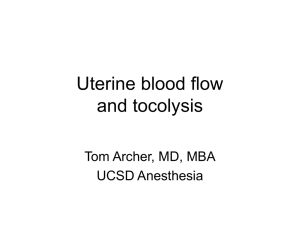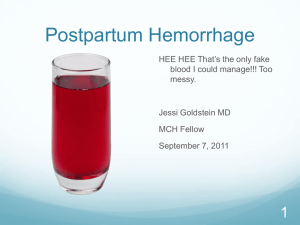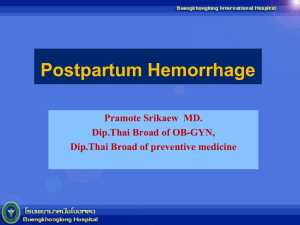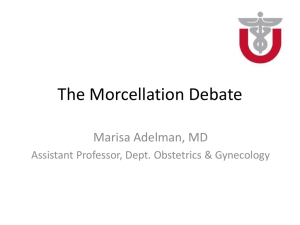A case report
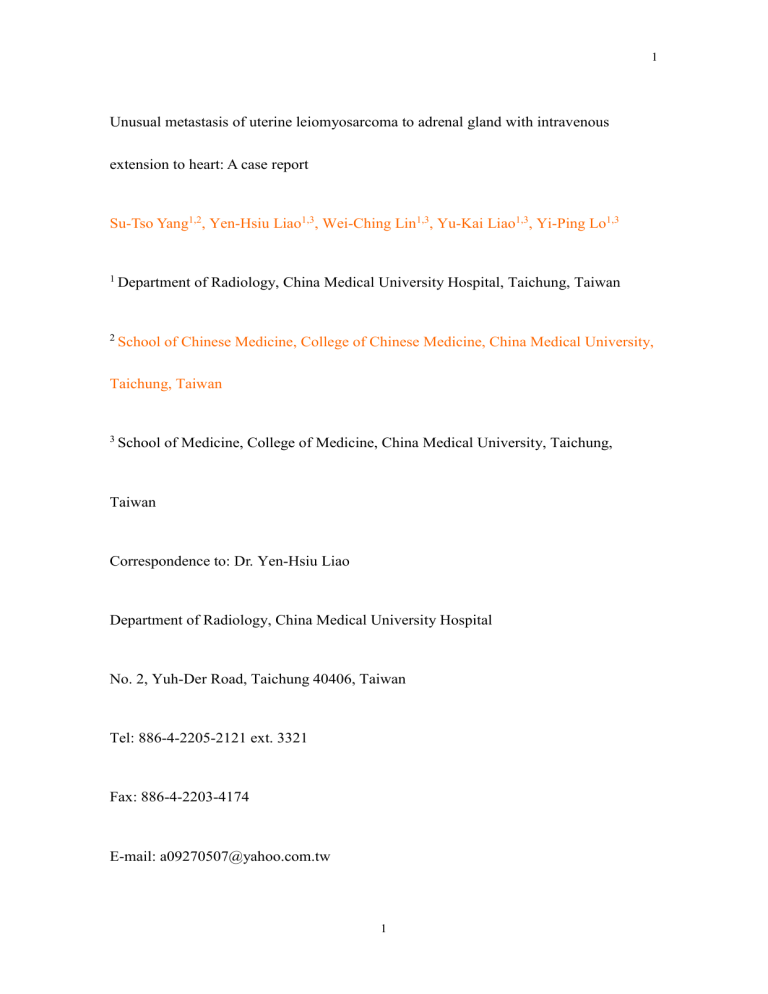
1
Unusual metastasis of uterine leiomyosarcoma to adrenal gland with intravenous extension to heart: A case report
Su-Tso Yang
1,2
, Yen-Hsiu Liao
1,3
, Wei-Ching Lin
1,3
, Yu-Kai Liao
1,3
, Yi-Ping Lo
1,3
1 Department of Radiology, China Medical University Hospital, Taichung, Taiwan
2
School of Chinese Medicine, College of Chinese Medicine, China Medical University,
Taichung, Taiwan
3 School of Medicine, College of Medicine, China Medical University, Taichung,
Taiwan
Correspondence to: Dr. Yen-Hsiu Liao
Department of Radiology, China Medical University Hospital
No. 2, Yuh-Der Road, Taichung 40406, Taiwan
Tel: 886-4-2205-2121 ext. 3321
Fax: 886-4-2203-4174
E-mail: a09270507@yahoo.com.tw
1
Unusual metastasis of uterine leiomyosarcoma to adrenal gland with intravenous extension to heart: A case report
Short running title: Unusual metastasis of uterine leiomyosarcoma
2
2
Introduction
Uterine leiomyosarcoma has the characteristics of a high local recurrence rate and a high metastasis rate. We report an extraordinarily rare case of left adrenal gland metastasis with intravenous leiomyosarcomatosis and intracardiac extention following the initial lung metastasis from original uterine leiomyosarcoma, clearly demonstrating a possible metastatic route of uterine leiomyosarcoma.
3
3
Case Report
Six years ago, the patient, a 52-year-old housewife, suffered from abdominal fullness with dysmenorrhoea and her pelvic sonography displayed three uterine myomas at a local hospital. Laparoscopically assisted vaginal hysterectomy was performed. The histopathology report was poorly differentiated uterine leiomyosarcoma. She was then transferred to our hospital, and further staging surgery with bilateral salpingo-oophorectomy, bilateral pelvic lymph node dissection, para-aortic lymph node dissections, bilateral adnexal vessels resection, rectal mesentary biopsy, and peritoneal washing cytology, were performed. Histologic evidences of fallopian tube and rectal mesocolon invasions were reported, and confirmed stage III disease. She received adjuvant radiotherapy with a total 5040 cGy in the 28 fractions and two cycles of chemotherapy combining adriamycin and ifosphamide.
After a 44-month regular follow up, chronic intermittent cough developed and chest computed tomography revealed two lung nodules in the left lung. Lung metastasis from uterine leiomyosarcoma was diagnosed by pathology after surgical resection. After a
20-month follow up since the first lung surgery, she gradually developed a new onset foreign body sensation with knocking tenderness in the left costophrenic angle area.
Initially, abdominal sonography revealed normal findings. Serial examinations with squamous cell carcinoma antigen, carcinoembryonic antigen and cancer antigen 125
4
4
5 were normal and without elevation for five months. However, further chest computed tomography revealed a left adrenal tumor with a diameter of 3.5 centimetres. Adrenal metastasis from primary uterine leiomyosarcoma was considered, and surgical resection was suggested, but the patient hesitated. Six months later, the left adrenal metastatic tumor enlarged in size to a diameter of 8.6 centimetres and was associated with tumour thrombus in the left adrenal vein, left renal vein, and inferior vena cava, as displayed by computed tomography (Figure 1). The patient decided to receive surgical resection one month later, In the meantime, ongoing tumor thrombus extension from the inferior vena cava into the right atrium was revealed by the transesophageal echocardiography
(Figure 2). After discussing with the family about the rapid tumor progression and surgical risks, the family decided to receive palliative treatment instead. The patient died one month later.
5
6
Discussion
Uterine leiomyosarcoma is a rare soft tissue neoplasm with an incidence of approximately 0.67/100,000. It comprised 1% of all uterine malignancies and approximately 25 36 % of uterine sarcoma ( Echt G et al. 1990 ) .
Radical primary surgery of uterine leiomyosarcoma with no residual tumor is of the utmost importance in treatment. Uterine leiomyosarcoma has a poor prognosis due to a high rate of recurrence and metastasis. While the majority of uterine leiomyosarcomas were diagnosed at an early and resectable stage, 50% of these cases recur after therapy.
Among them, 81% of women with stage III tumors had tumor recurrence, and only 8% of women with stages II–IV tumors survived for 5 years (Gadducci et al. 1996).
Leiomyosarcoma tends to metastasize haematogenously, principally to the lung, although other organs, such as liver and the peritoneal surface, are commonly involved.
The incidences of metastases in 73 autopsy cases of uterine leiomyosarcoma were
58.9% to the peritoneal cavity and 52.1 % to the lung. Other frequent metastatic sites were the pelvic lymph nodes (40.8%), para-aortic lymph nodes (37.5%), liver (34.2%), bone (23.3%), and brain (8%). Although rare, metastases to the kidney, heart, thyroid, parotid gland, oral cavity, pancreas, and breast have been reported ( Cruickshank et al.
1988; Lin et al. 2003; Rose et al. 1989; Saiz et al. 1998; Wronski et al. 1994 ) .
The high propensity for distal metastasis among women with uterine leiomyosarcoma
6
7 suggests that adjuvant chemotherapy might provide some benefit. Doxorubicin is the most active drug in the treatment of leiomyosarcoma. Ifosfamide and cisplatin can increase the response rate in combination with doxorubicin, but the substantial toxicity also rises. Unfortunately, the response rate of uterine leiomyosarcoma to chemotherapy is only 20%. Recently, the combined use of gemcitabine and docetaxel has demonstrated a high level of antitumor activity in pretreated patients, overall response rate of 55%. In fact, the rarity of uterine leiomyosarcoma limits the possibility of conducting randomized trials to demonstrate the role for adjuvant chemotherapy (Kapp et al. 2008; Giuntoli et al. 2008).
Vascular endothelial growth factor stimulates cellular responses by binding to tyrosine kinase receptors. A tyrosine kinase inhibitor, binding to tyrosine kinase receptors, can inhibit sarcoma growth by inducing increased apoptosis, decreased tumor cell proliferation, and decreased angiogenesis. Imatinib mesylate, a tyrosine kinase inhibitor, acts against a tyrosine kinase encoded by the KIT gene in the gastrointestinal stromal tumor, and is more effective in tumors expressing this protein. But KIT expression is very weak in the majority of uterine sarcomas, imatinib mesylate could not be used effectively as a single agent in patients with uterine sarcomas. More data is needed for assessment of the role of adjuvant chemotherapy in the rare uterine sarcoma
(Ren et al. 2008; Zafrakas et al. 2008).
7
After searching the database of Medline and Web of Sciences, only 12 reported cases of cardiac metastasis secondary to uterine leiomyosarcoma and only two cases of leiomyosarcoma metastasis from mesentery and small intestine to adrenal gland were reported in the English medical literature (Gohji et al. 1997; Sahin et al. 2010). So, this should be the first case report of uterine leiomyosarcoma with lung metastasis, adrenal metastasis, and intravenous leiomyosarcomatosis with intracardiac extension, clearly demonstrating a possible metastatic route of uterine leiomyosarcoma.
Declaration of interests:
This study was supported by the grant DMR-100-066 from China Medical
University Hospital.
8
8
9
References
Cruickshank JC. 1988. Leiomyosarcoma metastatic to the thyroid gland. Ear Nose
Throat J 67: 899–910.
Echt G, Jepson J, Steel J et al. 1990. Treatment of uterine sarcomas. Cancer 66: 35–39.
Giuntoli RL, Bvistow RE. 2004. Uterine leiomyosarcoma: present management.
Curr Opin Oncol 96: 524–527.
Gohji K, Kizaki T, Fujii A. 1997. Bilateral adrenal tumours: a case report of an unusual manifestation of mesenteric leiomyosarcoma. Br J Urol 79: 479–480.
Gadducci A, Landoni F, Sartori E et al. 1996. Uterine leiomyosarcoma: analysis of treatment failures and survival. Gynecol Oncol 62: 25–32.
Kapp DS, Shin JY, Chan JK. 2008. Prognostic factors and survival in 1396 patients
With uterine leiomyosarcomas: emphasis on impact of lymphadenectomy and oophorectomy. Cancer 112: 820–830.
Lin CH, Yeh CN, Chen MF. 2003. Breast metastasis from uterine leiomyosarcoma: a case report. Arch Gynecol Obstet 267: 233–235.
Ren W, Korchin B, Lahat G, Wei C, Bolshakov S, Nguyen T, Merritt W, et al. 2008.
Combined vascular endothelial growth factor receptor/epidermal growth factor receptor blockade with chemotherapy for treatment of local, uterine, and metastatic soft tissue sarcoma. Clin Cancer Res 14: 5466–5475.
9
10
Rose PG, Piver MS, Tsukada Y et al. 1989. Patterns of metastasis in uterine sarcoma. An autopsy study. Cancer 63: 935–938.
Sahin D, Cetiner H, Mirapoglu S et al. 2010. An infantile leiomyosarcoma that metastasized from the small intestine to the adrenal gland. Fetal Pediatr Pathol 29:
299–304.
Saiz AD, Sachdev U, Brodman ML et al. 1998. Metastatic uterine leiomyosarcoma presenting as a primary sarcoma of the parotid gland. Obstet Gynecol 92: 667–668.
Wronski M, de Palma P, Arbit E. 1994. Leiomyosarcoma of the uterus metastatic to brain: a case report and a review of the literature. Gynecol Oncol 54: 237–241.
Zafrakas M, Theodoridis TD, Zepiridis L, Venizelos ID, Agorastos T, Bontis J. 2008.
KIT protein expression in uterine sarcomas: an immunohistochemical study and review of the literature. Eur J Gynaecol Oncol. 29: 264–266.
10
11
Figure Legends
Figure 1a and 1b
The computed tomography including abdomen and pelvis with contrast enhancement in coronal sections revealed left adrenal metastatic tumor (black arrowhead) with heterogenous enhancement and tumor thrombus in the left adrenal vein, left renal vein, and inferior vena cava (white arrowhead).
Figure 2
A hyperechoic tumor thrombus (Tu) in the right atrium (RA) extending from inferior vena cava (IVC) revealed bedside by transoesophogeal echocardiography.
11



